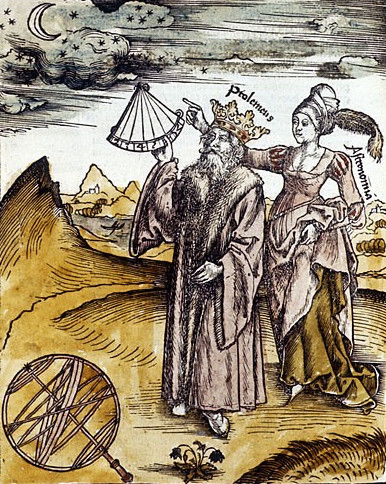
(Click to see how it works.)
by John P. Pratt
27 Nov 2018, 1 Rabbit (SR), η Dra (US)
©2018 by John P. Pratt. All rights Reserved.
| 1. Three Ordering Criteria |
| 1.1 Zodiac Grouping |
| 1.2 Object Grouping |
| 1.3 Connect the Dots |
| 2. Possible Exceptions |
| 2.1 Bright Stars |
| 2.2 Lunar Mansions |
| 2.3 First Days |
| 2.4 Dragon Stars |
| 2.5 Heavenly Stars |
| 2.6 Argo Stars |
| 3. Resultant Order |
| 4. Conclusion |
| Notes |
The Book of Enoch describes a Star Calendar with 364 days, each represented by a star, which in turn represents a servant of God. Earlier articles introduced such a calendar, laying the groundwork that the year is divided into twelve zodiac "months", each of which begins at noon on a Saturday.[1] A later paper even identified all of the stars by following seven criteria for star selection which had been discovered.[2] This article announces the discovery of three more criteria which have allowed all of the stars to have been placed in order. The intended double meaning of "stellar" in the title implies that not only are the stars being ordered, but also that the ordering is amazing!
The first section discusses the three new ordering criteria to be added to the previous seven. The next section discusses exceptions to these three rules and the third section presents the resultant ordering. It must be kept in mind that this is a work in a progress and that new discoveries could cause minor changes to that ordering, but it is felt that the order is stable enough that only small adjustments will be needed hereafter.
This article is somewhat technical and may be of interest only to those who really want to know the details of the selection and ordering of the stars in both the Star Calendar and the Uniform Star Calendar. The stars and their order are the same for both, the only difference between them is that the Star Calendar adds an extra week of stars in the Cup (Crater) between Leo and Virgo when needed to keep the star year synchronized with the heavens (sidereal year). On the other hand, you may want to read it because the highly advanced ordering technique is based on the simple childlike concept of "connecting the dots" (Matt. 18:3).
Before discussing the three new criteria to order the stars in the Star Calendar, let us briefly review the first seven criteria used to select the stars.
To be included in the Star Calendar, a star must be:
These seven criteria were useful to identify the stars, but only the fifth criterion helped with the actual placement of the stars in the calendar year. If, however, the stars were placed in the exact order of their longitudes, several questions would be raised.
 |
Second, the whole idea of a calendar is to replace making astronomical measurements by using a simple pattern (calendar) that summarizes the results. In other words, a calendar is designed to be used by the layman, not the astronomer. How is a layman to remember what star day it is?
Third, remember that the star calendar has an accuracy of only about a week. That is, when a 364 day calendar gets about a week off from the actual position of whatever is being tracked, then an entire week is added. That suggests that star days can be up to about a week off from the true position of the stars. A week is about seven degrees. What is the point of measuring star positions to a sixth of one degree when the calendar itself is only accurate to within about 7 degrees?
With that amount of variation in star position allowed, the question becomes just how to order the stars to be within about a week of the correct position in a way to maximize the ease of use by the layman.
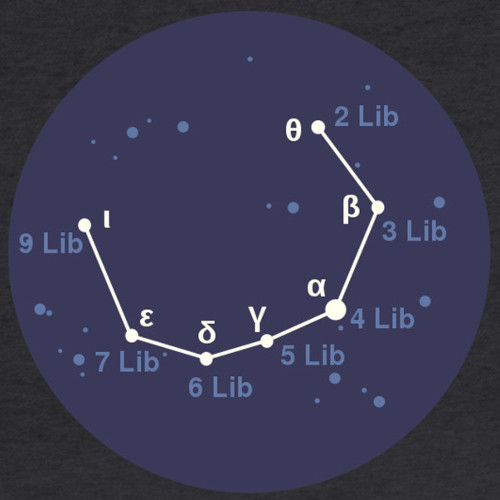 |
There were several examples where this principle became important. For example, all of the stars of the little constellation of the Crown (Corona Borealis) neatly fit into the Libra month except for one. One star in Hercules has a longitude to put it in the middle of the Crown. This rule allowed it to be moved by 4 days to be in the month of Virgo in order to allow all of the Crown stars to be together in Libra (see Figure 2).
Another example is the stars of the Big Bear are so spread out that they cover enough longitude to require at least two zodiac months. They barely fit into Cancer and Leo together, being the first star of month of Cancer and the last star of Leo. But it is clear that there should be no stragglers outside of those two months if they can all squeeze in.
The next principle is:
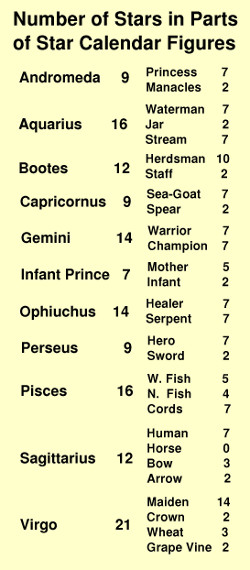 |
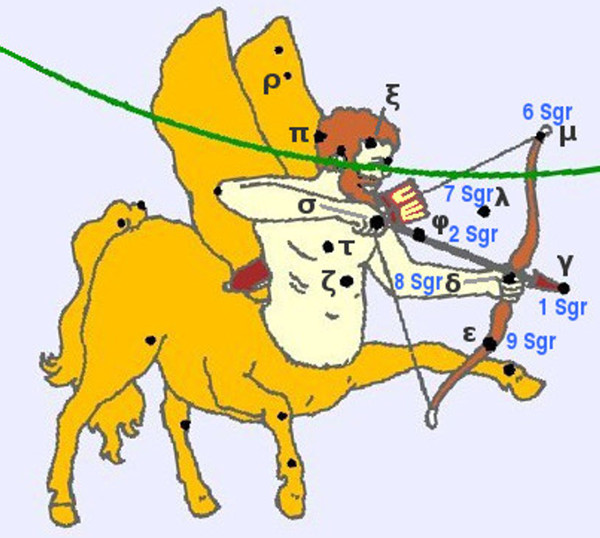 |
Another example of the power of object star grouping and of the number of stars in objects is with the Sea-Goat (Capricornus). An earlier paper showed that there was most likely a spear stuck in that sacrificial animal, but it was only represented by one star, which seemed strange. With 9 stars allotted in the Star Calendar and seven needed to represent the creature (being Christ), that leaves two for the spear. A new investigation led to the discovery of the two stars, having the required longitudes and even showing the spear pointing upwards and piercing the side, even as the spear pierced the Savior on the cross (see Figure 4). Is their any supporting evidence for the existence of this spear? Yes, Jacob's prophecy of Levi and Simeon says that there are "instruments of cruelty" in their habitations (Gen. 49:5). Levi (Pisces) has chains or cords in his zodiac house of birth, but what such instrument is in Capricornus for Simeon? A spear fills that requirement admirably!
Object grouping also allowed the discovery that indeed the Maiden holds a branch in her right hand and some wheat stalks in her left (Isa. 11:1), as she is usually depicted. The later Greeks left many objects out their constellation descriptions, including both of these. While most illustrations show a palm branch, a grape vine is more likely because the very old name of the star, quoted by Aratus, means "Grape Maiden". Indeed, it the name of the bright star Spica in the Maiden which preserves the fact that she holds wheat in her other hand because that star name means the "ear of wheat". The other two stars which are in the wheat stalks are χ Vir and ψ Vir, which have been named the Root and Stem respectively.
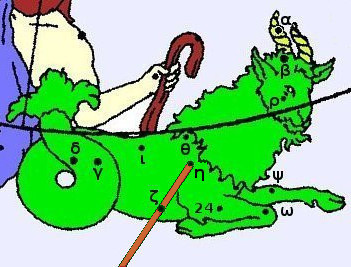 |
This is a surprisingly powerful principle which children can easily understand. It solves the problem of stars with very similar longitudes. One can simply draw the stick figure! This has the wonderful result of removing nearly all ambiguity of ordering the stars.
The constellation of the Herdsman (Bootes, pronounced Boe-OH-tees) is an excellent example (see Figure 5; can you find the Crown?). All of its 12 calendar stars fit easily into the long 7-week month of the Maiden (Virgo), so Criterion 8 is easily satisfied. Although many illustrations show a sickle in his left hand, it was not mentioned in the ancient descriptions. In his right hand is a shepherd's staff which has the two stars μ and ν, so they should be adjacent to each other.
Most of the other stars can be put in order by the "connect the dots" rule as shown in Figure 5. Note the star days 31 Vir to 35 Vir simply trace up the left side of his body from foot to head. Similarly, the stars on his right side, including the staff, are put in the same ascending order from 38 Vir to 42 Vir. The two intervening slots of 36 Vir and 37 Vir are needed for stars within the Maiden herself. These runs of five days straight are possible because the constellation is more or less vertical in the sky so that the stars on each side have similar longitudes.
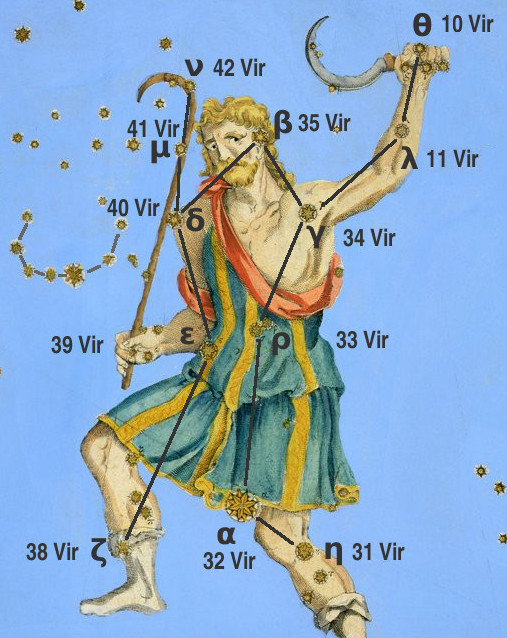 |
Another excellent example, which led to the inclusion of the word "stellar" in the title, is the case of the Twins (Gemini). They are not shown vertically in the sky as is Bootes, but rather obliquely, being nearly in a horizontal position. Thus, they provide a good test case in connecting the dots because one cannot simply trace up each side.
The result is shown in Figure 6. It contains much more information than expected by simply connecting the dots. To keep the longitudes similar, increasing with the days from right to left, the lower portions are drawn first and then the upper. This emphasizes the striking similarity between the Twins. Note that there is even a gap of several days between the first star of each twin in his left foot until the next star. This gap suggests that the similarities between the upper portions is important. To have such hidden information contained in simply connecting the dots was totally unexpected.
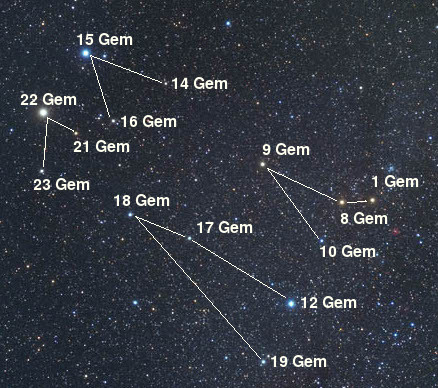 |
There are some exceptions to those three ordering principles. Let's look at each.
Most bright stars follow these ordering principles. For example, Arcturus, α Boo (stars are designated with a Greek letter along with the constellation name, see Table 2), is the second brightest star in the entire Star Calendar. It is shown in Figure 5 near the left knee of Bootes as day 32 Vir. It gets no special treatment, but is just connected in the line of star dots with the others. One witness is that it is on the correct star day is that 32 Vir was the day on which Noah was born. Many of the greatest prophets were born on the days of either bright stars or holy days.
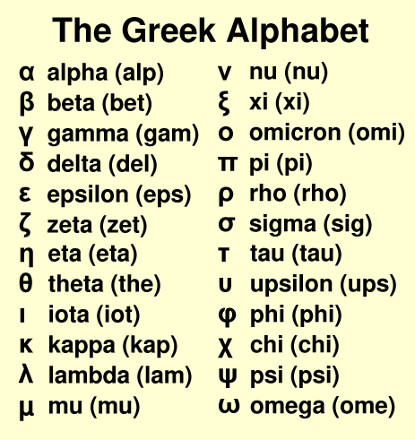 |
A recent article identified 28 stars as "lunar mansions" which mark the daily progress of the moon.[4] They were considered important to the ancients and turn out to all be holy days in the Star Calendar. The fact that these star days are considered to be minor holy days does not appear to affect their placement, so they are not really an exception to the placement criteria.
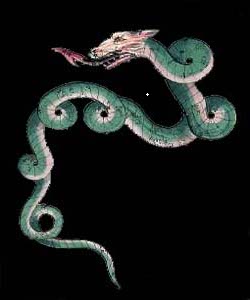 |
The best test case came in the constellation the Crab (Cancer). There is no Crab star near the beginning of its mere two week length. It was decided that indeed the first day of each zodiac month must be a member of that constellation because the Book of Enoch speaks of twelve captains, one for each month, which apparently need to be separate chairs from the 24 lunar mansions around the throne of God and need to truly represent that constellation. It is similar to the need of a government leader of a state needing to reside in that state.
The twelve stars in the Dragon represent God and surround the ecliptic pole, which represents the center and highest point of heaven (see white dot in Figure 7).[5] The Dragon stars are allowed to break the rule of Criterion 8 because it is at the top of the sky so its stars have longitudes in many zodiac constellations. None of its stars fall onto adjacent days.
The constellations which surround the Dragon, near the center of Heaven, are all considered to be celestial and also generally have longitudes which spread over more than one zodiac constellation. These include the Swan (Cygnus), the Flying Horse (Pegasus) and the King (Cepheus).
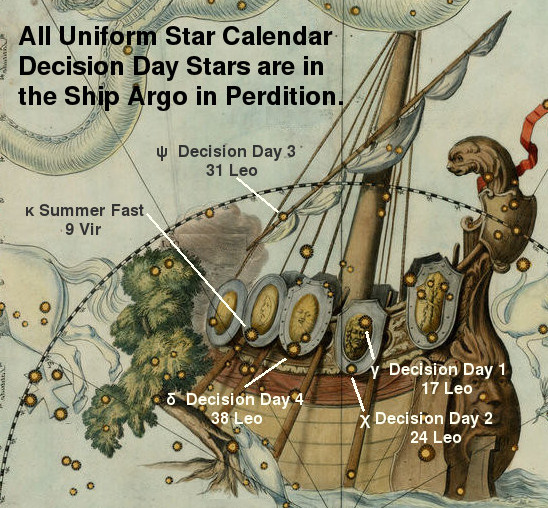 |
The myth of the Argonauts implies those sailors were men seeking a good resurrection. That is, they were in search of the golden fleece of the Ram, which provided everlasting life. Moreover, they were led by some righteous heroes, such as Castor and Pollux (the Twins). Thus, they seem to represent those in hell who were deceived into following Satan, but are not truly evil. Those are the very ones who will spend a thousand years of the Millennium to decide whom they really want to follow, Christ or Lucifer.[6] It was decided to include Argo in the calendar without knowing exactly how the stars would be used.
Another issue with the Ship is that it sails extremely close to the center of Perdition, namely, the south ecliptic pole, located at the point of the converging lines at the bottom center of Figure 8. In that sense, it is the south polar counterpart of the Dragon. Thus, its stars are also spread out in longitude to cover more than one constellation.
What are these stars good for? What does it mean if someone is born on one of these star days? The use of these 8 stars (8 symbolizing resurrection) is now clear. These are the stars used for the Decision Days and Fast Days which are usually associated with bad decisions and tragedies, such as the Fall of Eve and Adam and the destruction of the temples (commemorated by the Summer Fast). They are technically not evil per se, but often represent bad decisions. It is impressive that several of these stars have longitudes separated by one week even as the Hebrew and Enoch Decision Days are a week apart!
Now the results of applying these criteria can be presented. The stars are divided into four seasons, each shown in a table. Even though both star calendars rotate through the seasons, in the case of the Uniform Star Calendar (US) there is a permanent tie to the Uniform Enoch Calender (UE), which has four seasons. Both calendars always have 364 days, so every US star day always falls on the same UE day.
The precise alignment of the Uniform Star Calendar with the Uniform Enoch Calendar is that the first day of summer and of winter (UE) both fall on the first day of a zodiac month. That is, the morning of 1 Summer (UE) always falls on 1 Leo (US) and that of 1 Winter (UE) always coincides with 1 Aquarius (US). Thus, 1 Leo represents the first day of summer (US) and 1 Aqr the first day of winter (US). In fact, the Beginning of Mortality on Sunday morning, 9 Apr 4001 BC, fell both on 1 Sum (UE) as well as on 1 Leo (US).
Thus, the four following tables of the 364 stars in the Uniform Star Calendar are divided into the four seasons of the UE year. The UE day numbers are printed in large very light numbers in each day box. There is no need to print the Enoch month names because each season has the first 30-day month as the season's name, the next 30-day month is "Mid" season and the last is "Late" season. The final day of each season is day 0 of the next season, being either an equinox or solstice day.
The first day of each zodiac month begins on a Saturday at noon. Because we are used to a weekly calendar beginning each week on a Sunday, it was decided to ask the reader to remember that when the first day of each month is shown as Sunday, that it is really only Sunday morning that is implied. That first day also includes the previous Saturday afternoon.[7]
The following results show the star for each day along with my suggested English name for the star, when its meaning is well enough known to justify a name at this time. It should be remembered that each star day always falls on the same day of the week and of the UE Calendar.
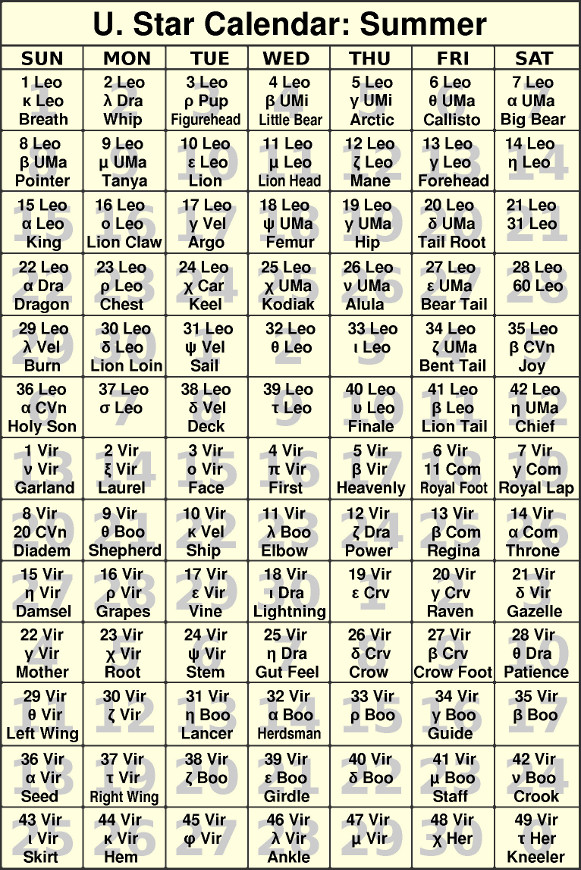 |
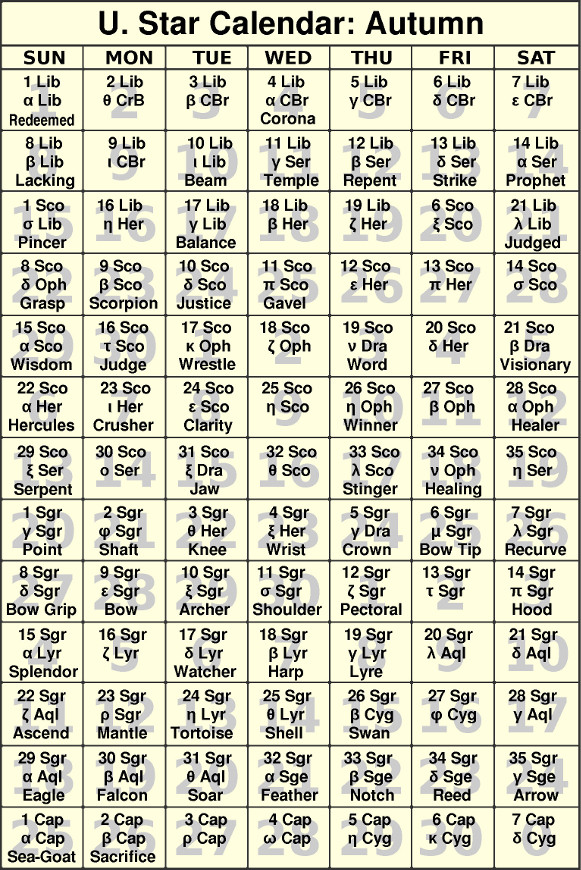 |
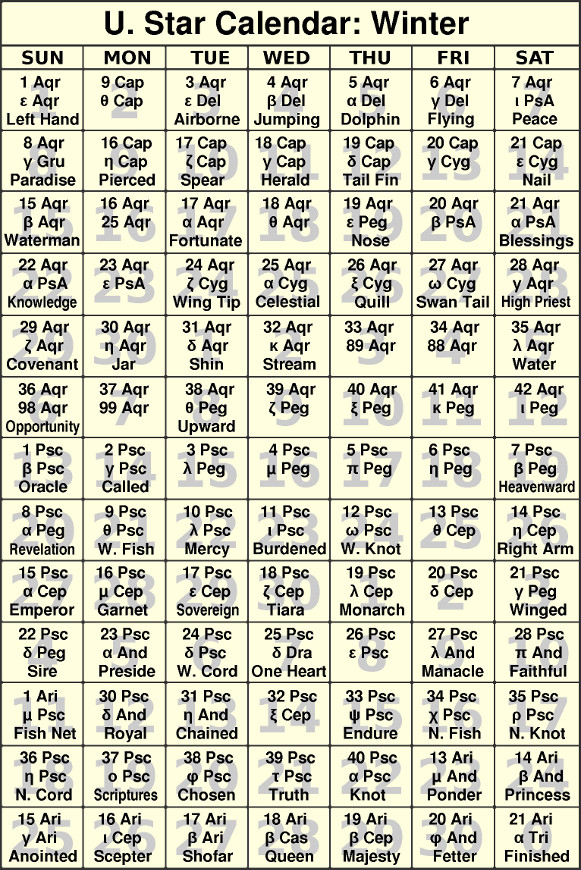 |
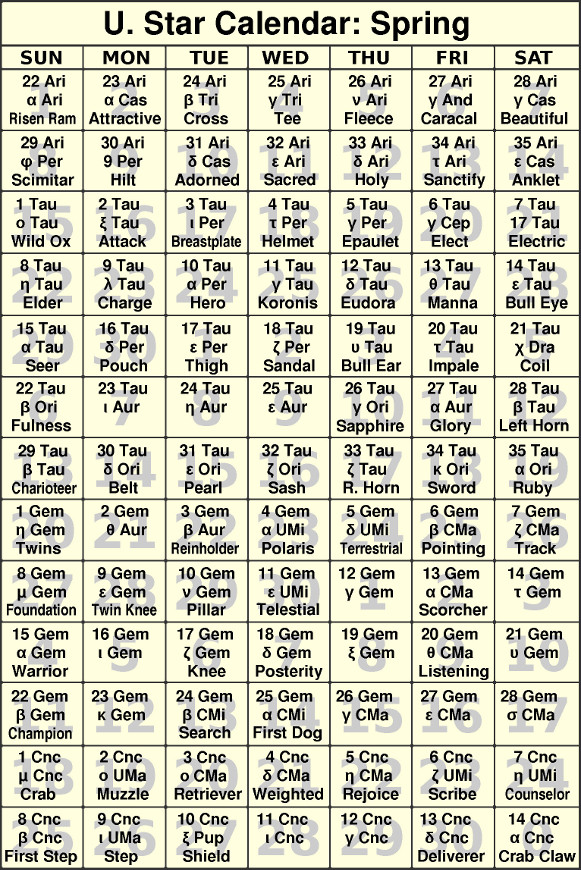 |
A spreadsheet with all of this information in standard format (comma separated variables), as well as precise star positions and brightnesses, can be downloaded from my website johnpratt.com under the heading "Star Calendar Star Catalog". The days are arranged in order starting with Virgo, the first constellation of the zodiac, and ending with the extra seven days after Leo. Those stars are not included in the following tables. Those seven stars, comprising the Cup (Crater) and numbered 43 Leo-49 Leo in the Star Calendar, are in order: θ Crt, ε Crt, δ Crt, α Crt, γ Crt, ζ Crt, and η Crt.
Three new criteria were introduced to order the 364 stars of the Star Calendars which were selected in a previous article by using seven other criteria. The results were almost unambiguous, removing nearly all doubt about the order of placement of days with similar longitudes. The most powerful rule was simply to "connect the dots" to draw the simple stick figure that was required in the first set of selection criteria. Thus, it is believed that this association of a star with each of the 364 days of the Uniform Star Calendar is accurate enough not to require any major changes hereafter.
It is clear that the Star Calendars were designed to be used by the layman, including simple principles such as drawing out simple star stick figures in the order of the days. Moreover, some small constellations have all of their stars together, such as the Arrow and the Dolphin. The entire calendar is a witness that God's house is indeed one of order, meant to be appreciated by His children. We have a wonderful Creator!